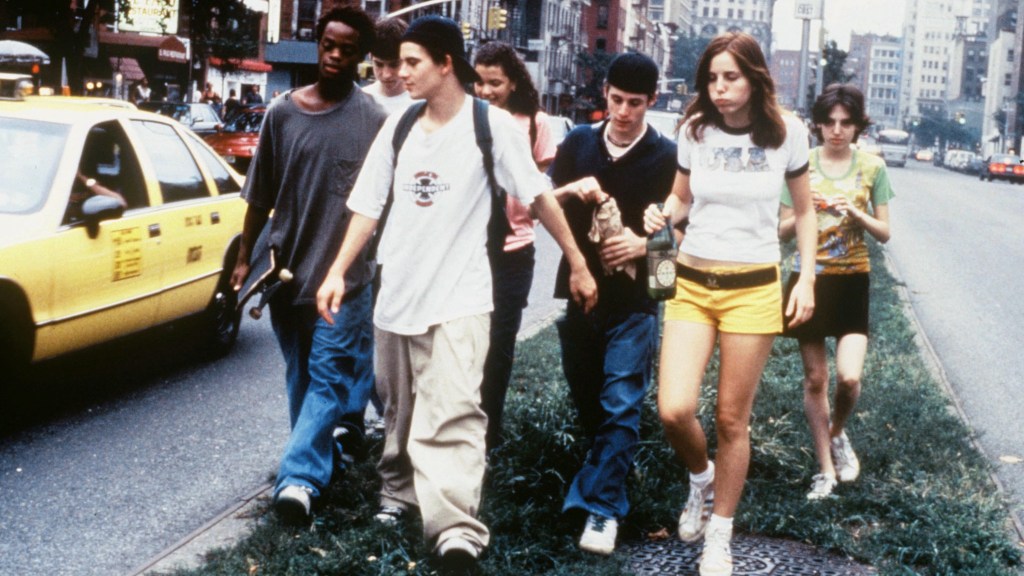Anyone who grew up in the ‘90s likely remembers Larry Clark’s Kids as a notorious teen film not necessarily meant for consumption by actual teens. When the picture was submitted to the MPAA for classification, the organization slapped the flick with a dreaded NC-17 rating. The film was ultimately released unrated and managed to rake in an impressive $20 million at the global box office. Some of the picture’s financial success surely stems from the controversy it caused. A vocal faction of moviegoers and critics was outraged by the onscreen depictions of teenage sexuality and drug use. The heavy themes depicted within likely have something to do with why the film is so hard to track down online these days.
Videos by ComicBook.com
The flick is unavailable to stream via any subscription-based services, and it’s also conspicuously absent from digital retailers as a rental or download. Moreover, Kids also appears to be out of print on physical media. There are a couple of potential reasons for that. In addition to the heavy themes putting off potential distributors from licensing the picture, the chain of custody regarding distribution rights is also fairly complex. Shining Excalibur Films, a one-off distributor owned by Harvey and Bob Weinstein, holds the copyright to the picture. Given that their subsidiaries are all effectively defunct, the film likely won’t be widely available until a transfer of ownership or licensing agreement is struck.
Kids Is One of the Most Controversial Movies of the ‘90s, And It’s Becoming Increasingly Hard to Find
If you have the burning urge to track down this boundary-pushing flick, you can still acquire copies of the DVD release on the secondary market. If you’re wondering if this lost effort is worth tracking down, that depends entirely on who you ask.
Some critics saw great merit in the film as a cautionary tale served up as a slice of teenage life. Others took care to praise the pseudo-documentary style for the way it works to immerse the viewer in the narrative, making them feel like an unwilling participant.
Some fans of this feature have even said that this gritty picture scared them straight after taking it in at an impressionable age. One Reddit user recalls that the flick encouraged them to practice abstinence thanks to depictions of teen sexuality with potentially deadly consequences.
In case you’re unfamiliar, the film follows Telly (Leo Fitzpatrick), a teenager with designs on sleeping with as many young women as possible. Little does Telly know, one of his previous sexual partners is HIV positive. Blissfully unaware, Telly continues to bed young girls, namely virgins, spreading the virus in the process. The themes explored within the film would be plenty mortifying if the protagonists were of legal age. Yet, their reckless behavior is even harder to take knowing that the key players are just children.
Some of the film’s most vocal detractors called the picture out as exploitative for its uncompromising depictions of teenage sexuality, drug use, and criminal mischief. Though director Clark and screenwriter Harmony Korine stated that they intended to provide a glimpse into teen culture without adult oversight or judgment, many felt that the film needed a stronger moral compass, to take a stand and condemn the criminal actions of the core characters in Kids.

The film’s outspoken critics make valid points, but it’s hard to discount the fact that Kids serves as a cautionary tale about a misspent youth that is unflinching in its perspective. The level of rawness within is certainly hard to take. Yet, one of the hallmarks of good art is that it makes you feel something. For better or worse, Kids absolutely makes viewers feel something, and it has made a lasting impression on the pop culture pantheon in the years since its 1995 release.
No matter where you stand on this picture’s merit, or lack thereof, it remains one of the most controversial films of the ‘90s. The core themes were boundary pushing at the time of release and remain so to this day. The film’s unsavory reputation likely remains a factor in its lack of availability. If you’d like to track it down, your best bet is to pick up a used copy via the secondary market.
Have you taken in this controversial and upsetting effort? If you have, we would love to hear your take in the comments section below.










